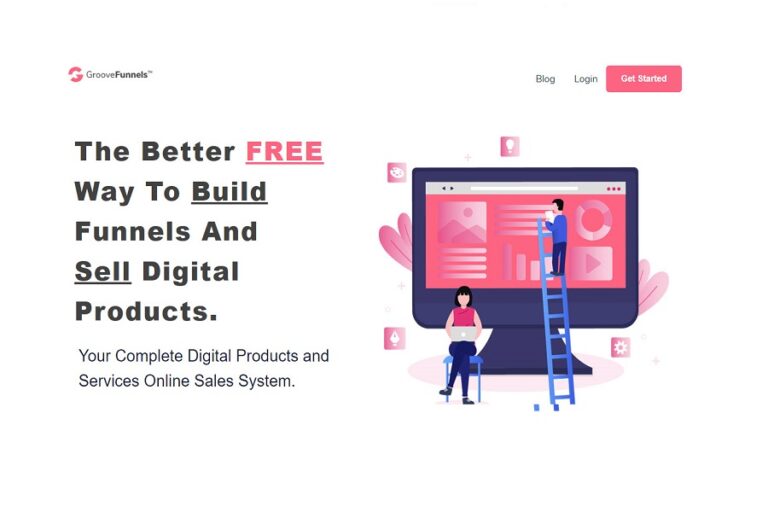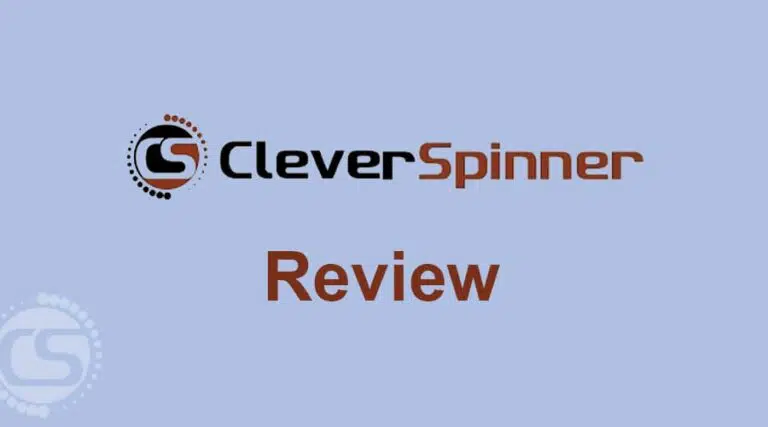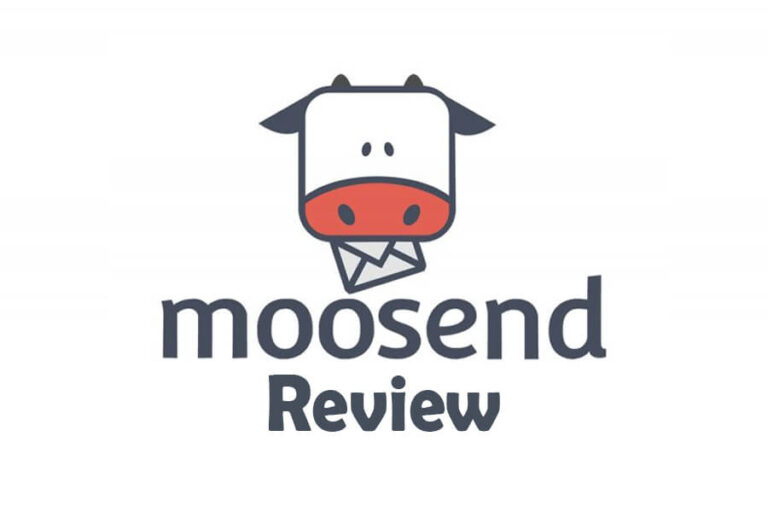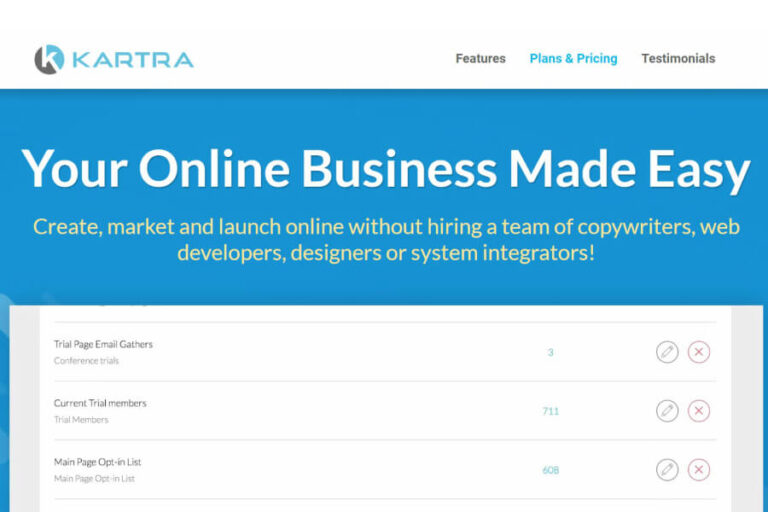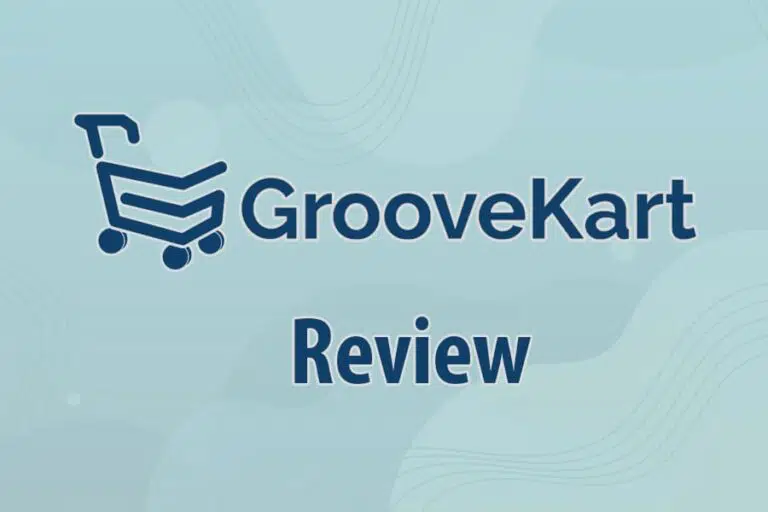In today’s blog post, I will provide you with my honest Mailchimp review. If you are looking for an email marketing services provider and are interested in Mailchimp, I recommend reading this post before subscribing to Mailchimp.
Email marketing is an essential part of content marketing. If I were to talk about monetizing your blog without emphasizing email marketing, I would be keeping you in the dark.
Email communication helps develop a bond between you and your subscribers. You can educate them about your product, offer them discount coupons, provide tips, or launch the product.
Many newbies use a WordPress plugin to send emails, which is not the most effective way of sending emails. It causes SPAM issues and a low deliverability rate, which could affect your business reputation.
I would recommend you use a reputable email marketing service provider for your email marketing requirements.
One such email marketing service provider is Mailchimp, and in this blog post, I will explain if this email service provider is a good fit for you or not.
Mailchimp Review
In this Mailchimp review, I will take you through Mailchimp, its features, pros, cons, and advanced functionalities.
Let’s dive in.
Mailchimp Review Summary
Below is a short brief of review of Mailchimp
Pros
Cons
Overall rating : 4.0 / 5
Conclusion
Mailchimp is the most popular email marketing software and offers the most generous plan for beginners. Though, paid plans are costly, if you are a beginner, it can be the best choice for you.
What is Mailchimp?
I came to know Mailchimp ten years ago when I started blogging. I joined the free Mailchimp plan to deliver our eBook to the audience.
The catalyst was the Mailchimp free plan. It was offering a free plan for up to 2,000 subscribers. At that time no other email marketing service had a free plan like Mailchimp. I believe this is the primary reason for its popularity.
In the free plan, you can create a few automations. Though the premium users enjoy the most benefits, it is still one of the best free email marketing tools for beginners, intermediaries, and experts.
Mailchimp is an email service provider that allows users to send email campaigns to promote their brands, businesses, products, or services. It also allows users to create simple landing pages to collect leads and build an audience.
If you are new to content marketing, understand that email marketing software is a service-based platform that allows users to run email marketing campaigns.
There are many email marketing software businesses out today that have various features, services, and functions. Some examples of email marketing software are ConvertKit, MailerLite, Moosend, Constant Contact, etc.
Email marketing is the most effective marketing tool, and most marketers use email more than other platforms because it allows you to get into their inboxes. It employs both direct and digital marketing to promote your brand and services.
Customer Relationship Management (CRM)
Only a few email marketing service providers offer CRM — Mailchimp is one of them.
CRM refers to methodologies and software concerned with the customer and lead. It is a business strategy that helps you understand and manage your customers and their requirements. The essence of CRM is to satisfy and win the contacts’ loyalty.
The CRM in email marketing enhances relationships with your subscribers.
Email Marketing Automation
Email marketing automation is artificial intelligence that makes your messages personalized and timelier. It converts the dispatch of email messages from a manual process to an automatic one.
Studies have shown that using email marketing automation leads to an 80 percent rise in the leads generated and a 77 percent increase in conversions.
It provides sustained engagement with potential and existing customers.
Customer Journey Builder
Customer Journey Builder is another prominent feature of Mailchimp.
This journey builder helps create an automated email-based sales funnel for your business. You determine the process flow for different segments of your contact based on their responses to previous emails.

From the diagram above, you can see the process flow and the different conditions for actions.
Why You Should Use Mailchimp
Now I will highlight the reasons you should use Mailchimp. Some reasons are:
#1. Email Automation
Mailchimp has a well-designed intuitive automation feature. This feature is not just for marketing emails but also for transactional emails. You can run Google, Instagram, Facebook ads, and offer coupons, so you map out the entire customer journey.
You can send reminders to users about their abandoned carts, offering discounts on different occasions, and send emails to the relevant groups. You don’t have to write and send emails to individuals at all times.
Automation customizes the user experience and meets your marketing needs without requiring a marketing team.
#2. Forever Free
If you are just starting, Mailchimp’s “Forever Free” is a go-to.
You can have 2,000 subscribers and could send 12,000 emails per month free. Once, there was a time when no other Mailchimp alternative or competitor was offering a similar generous free plan.
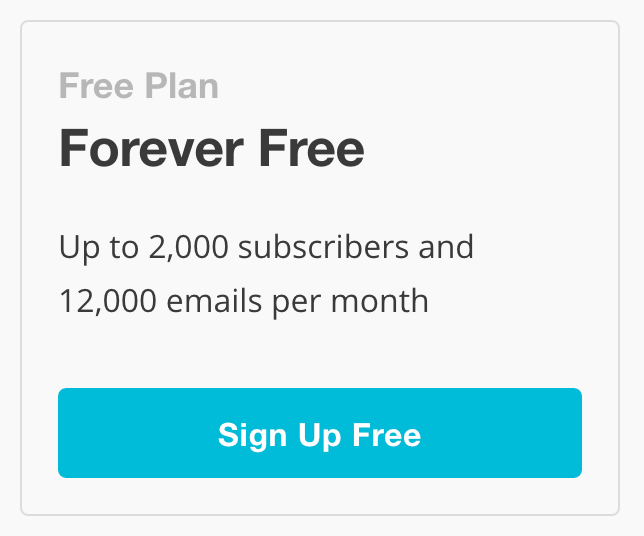
It does have limited features (but enough to get started), and when your email list grows beyond this number, you can join a paid plan.
#3. Custom Forms
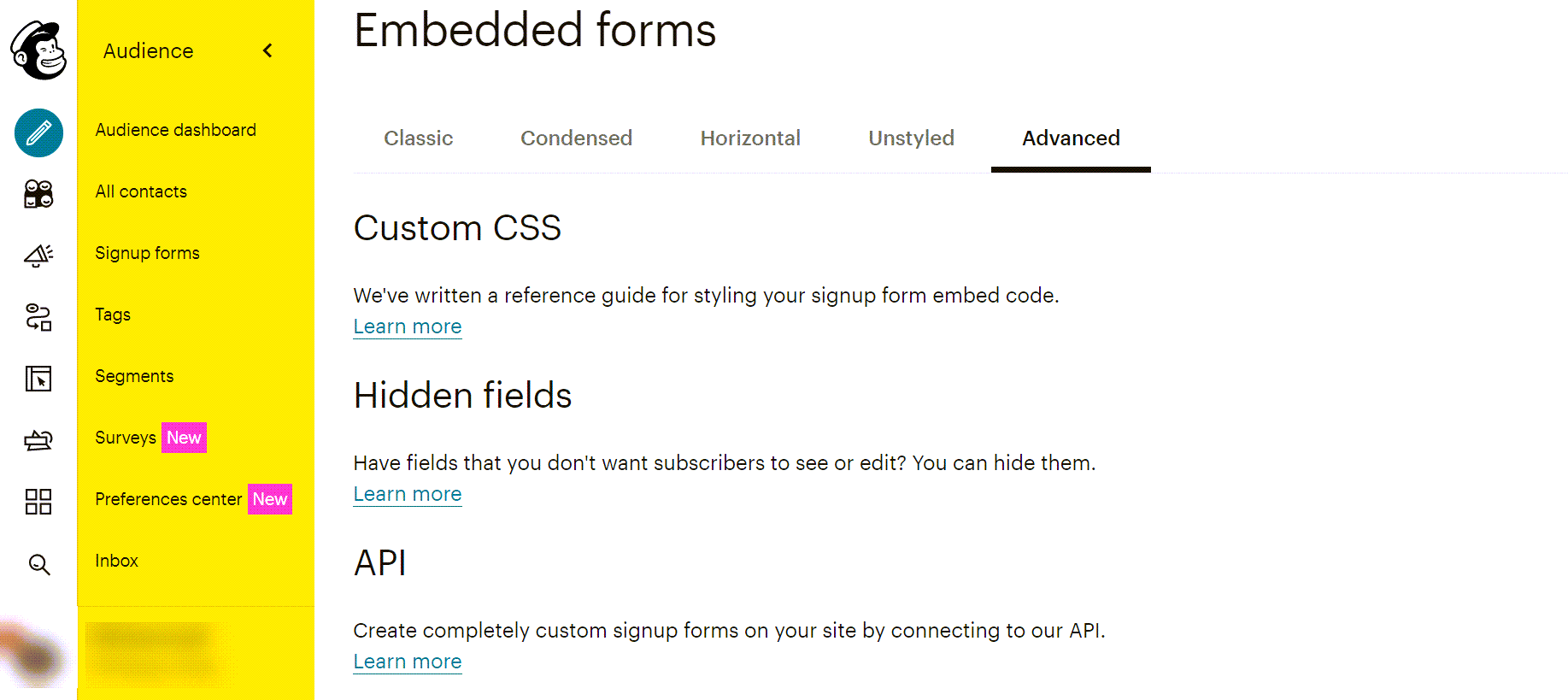
Sign-up forms let you collect leads. Mailchimp provides pre-built templates to get started quickly or with a free canvas if you have design skills.
You can customize forms to suit your needs and add your company’s logo.
If you have CSS skills, you can design custom forms using Mailchimp’s Advanced form design options.
#4. Reports and Analytics
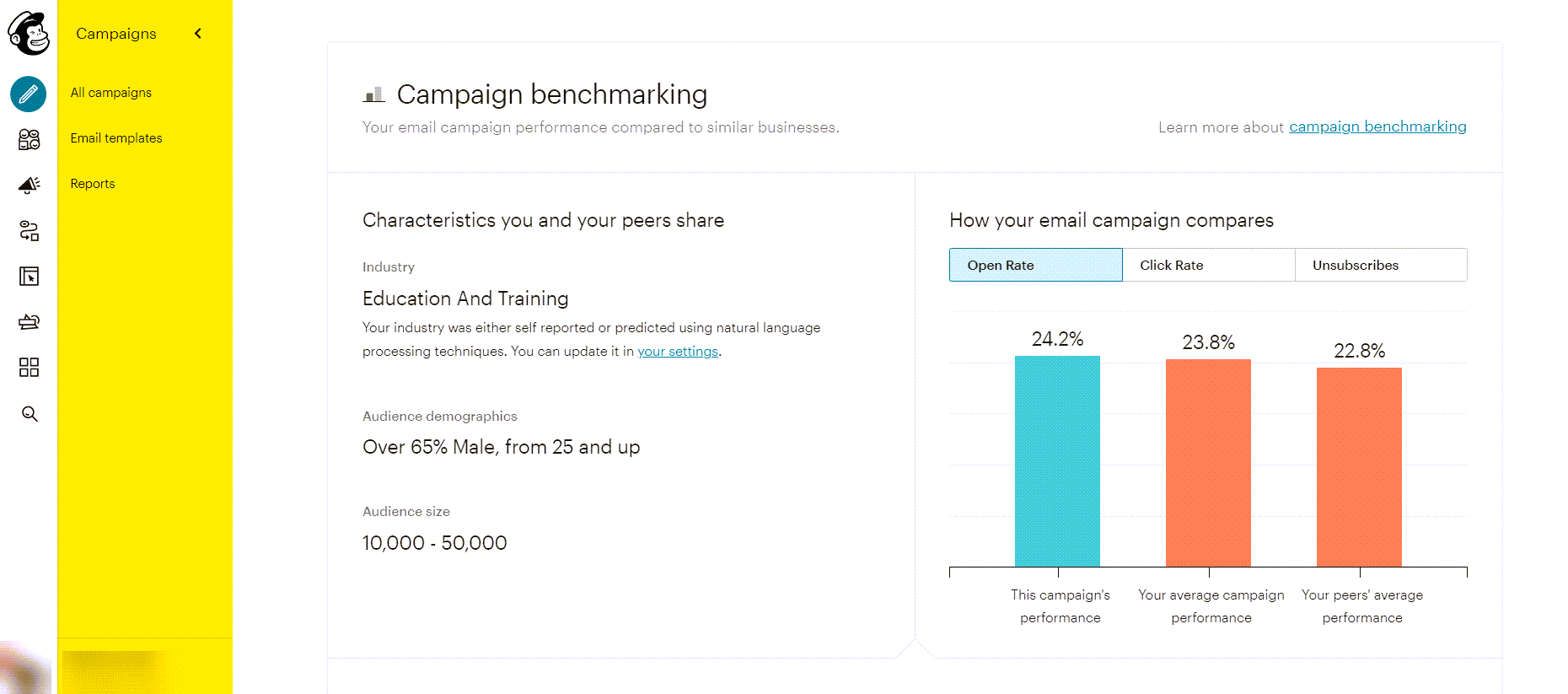
Mailchimp provides you with detailed reports of your campaigns and lets you know how your campaigns perform across different devices and social media platforms. You use the insights of previous campaigns and use them for future campaigns.
Mailchimp provides you a robust report, and you can see your success and failure. You can see this information through interactive charts and graphics.
This invaluable feedback eliminates the need for an email marketing expert. From the report, you can make professional decisions by yourself.
#5. Ease of Use
Mailchimp was launched in 2001, and since then, it is getting more advanced and user-friendly. You can choose from templates and set your layout and text using the simple drag-and-drop design feature.
From my experience, I can say that it is easy to use. Mailchimp allows non-techie people to send professional emails.
#6. Data Security and Privacy
Mailchimp takes proactive steps toward ensuring security. There are message transfer agents (MTAs) in data centers and other physical and electronic safeguards to secure those centers.
They store mailing lists in individual databases to mitigate data corruption or overlap. They also have an internal security team to test vulnerabilities.
If you need further clarity on security, Mailchimp is just the answer you seek.
Overview of Mailchimp Features
Now we will discuss a few salient features of Mailchimp.
#1. Marketing Automation
Automation is key to email marketing. Marketing without automation would be draggy and affect your engagement and conversion rates. With automation, you can do the following:
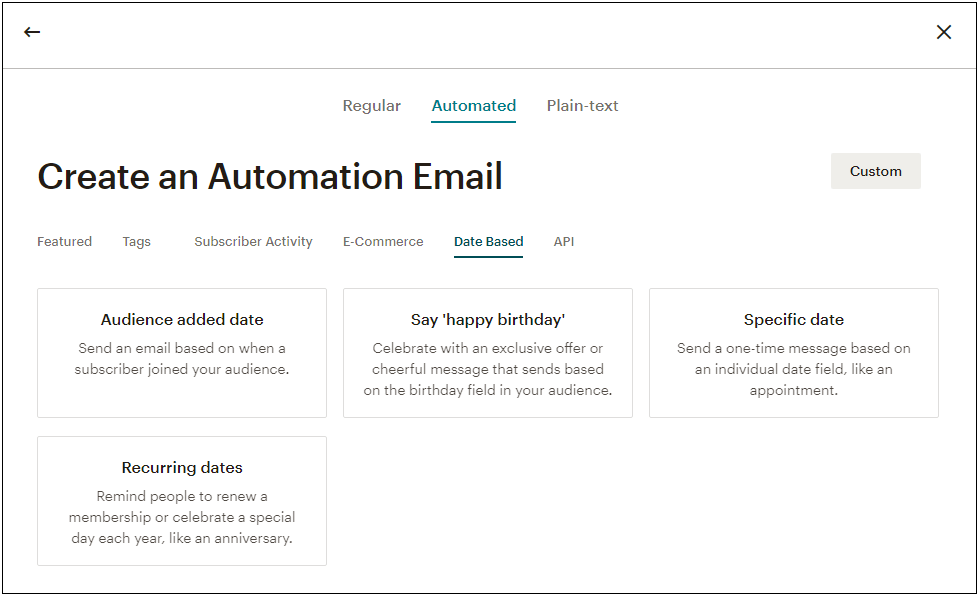
- Autoresponders: You can send a sequence of emails automatically based on the set conditions. Automation helps reach new contacts as soon as they sign up, such as sending an email the day after they join your list. You can set up auto-responses for events such as contact’s birthdays or any festive season.
- Recover Abandoned Carts: This is one of the most impressive features of Mailchimp automation. You can send email reminders to customers who have left their cart to complete their purchase.
- Feedback: You can get feedback from buyers by sending a quick survey, ask for a review, or offer helpful advice. You can set the time for the feedback, for instance, ten days after purchase.
- Remarketing Ads: Mailchimp allows you to create Google and Facebook remarketing ads automatically so your campaigns can reach users as they continue to surf the web. You can re-target your visitors who did not buy on the first visit and provide incentives; there is a higher chance of making purchases.
#2. Landing Pages
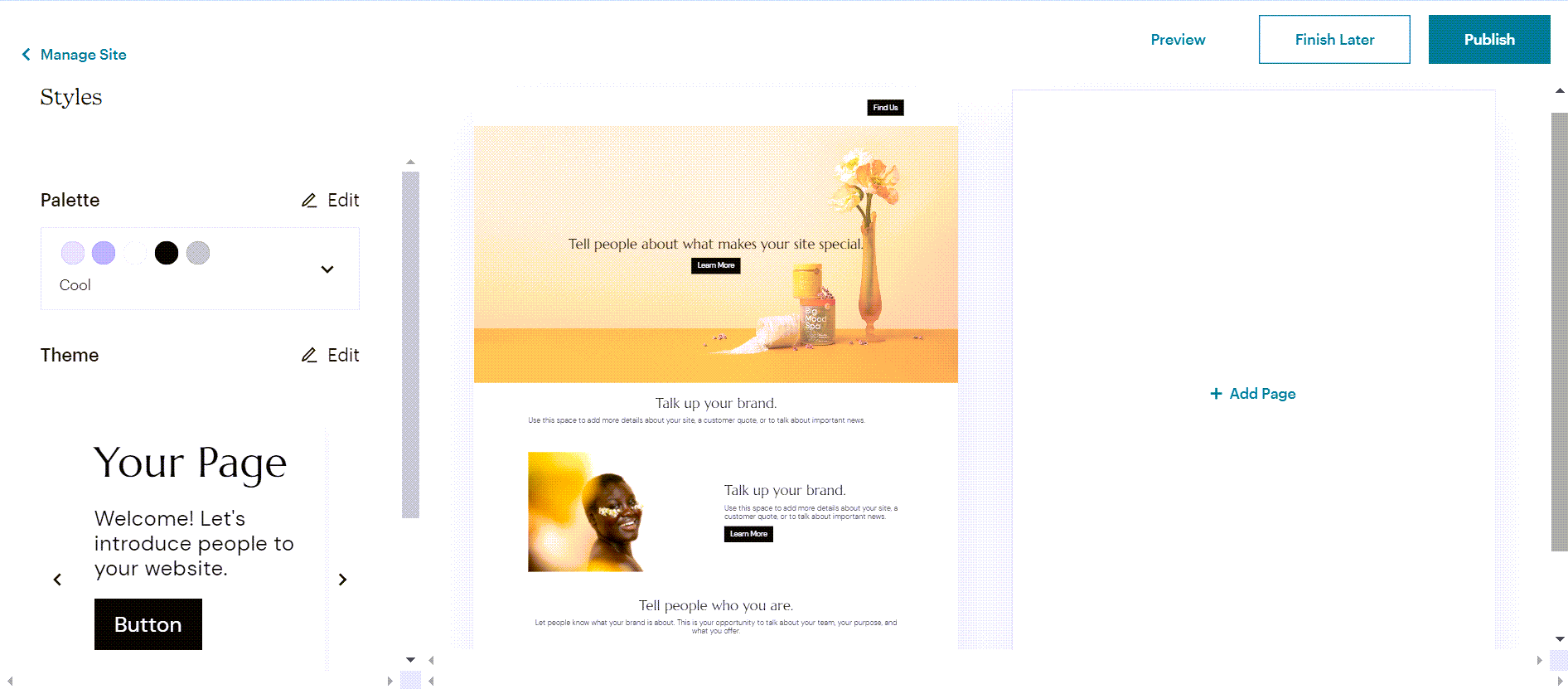
With Mailchimp, you can create as many landing pages as you want. You can use the built-in landing page builder on every plan. There are two types of landing page builders: you use one to build your email list and the other for product promotions.
However, this feature is basic, so you should use a dedicated landing page builder like Thrive Architect, Elementor, Beaver Builder (for WordPress users), Unbounce, Instapage, or GroovePages (for the cloud-based platform) to increase conversions.
#3. eCommerce Integration
Mailchimp eCommerce is a premium feature. You can integrate the WooCommerce store with Mailchimp.
You can synchronize your WooCommerce products, orders, and customers. Any alteration in WooCommerce will be reflected in Mailchimp.
You can track your campaign performance by evaluating your campaigns’ exact revenue. The tracking feature indicates the campaign your visitor was coming from before making a purchase.
Another feature that I discussed is the abandoned cart recovery on Mailchimp.
Mailchimp automatically separates your contact lists based on the purchases.
Mailchimp uses the knowledge from previous purchases and merges them with what your subscribers and customers would want to buy next. This is an advanced feature of Mailchimp.
#4. Forever Free
The free account will limit you from using many marketing features, but you can use it forever as long as you don’t surpass 2,000 subscribers. I used it until I got more than 2,000 leads; once I surpassed this number, I migrated to the paid plan.
The free plan lets you send up to 12,000 emails every month.
#5. Social Media Advertising
You can create social media posts and ads. Click on the “create campaign” to create a social media campaign. Mailchimp supports Twitter, Facebook, and Instagram.
You need to select a name for the campaign, add the text, and insert the pictures, and then you can customize it to fit the specific social channel you are aiming for. Then, you are set to launch the campaign online. Once your ads are live, Mailchimp will keep you updated on the posts’ statistics so you can make data-driven decisions.
#6. Mobile Functionality
A large percentage of your visitors will access your campaign from their mobile. Therefore, mobile responsiveness is necessary. All campaigns created in Mailchimp are mobile responsive.
Mailchimp provides a mobile app for managing your email marketing. You can add a contact to your audience, check your stats, and even create or send a campaign. It is flexible, and you can do many tasks with it.
Not all email marketing service providers provide a mobile app.
#7. Building Websites
Mailchimp has grown into a full-blown marketing automation platform. It is a website builder and allows you to create your website without writing a single line of code. They provide templates so you can select the one and build your website.
You can make adjustments using Mailchimp’s visual drag and drop builder. You could alter the text color and typography of any content block on a webpage.
#8. Editor
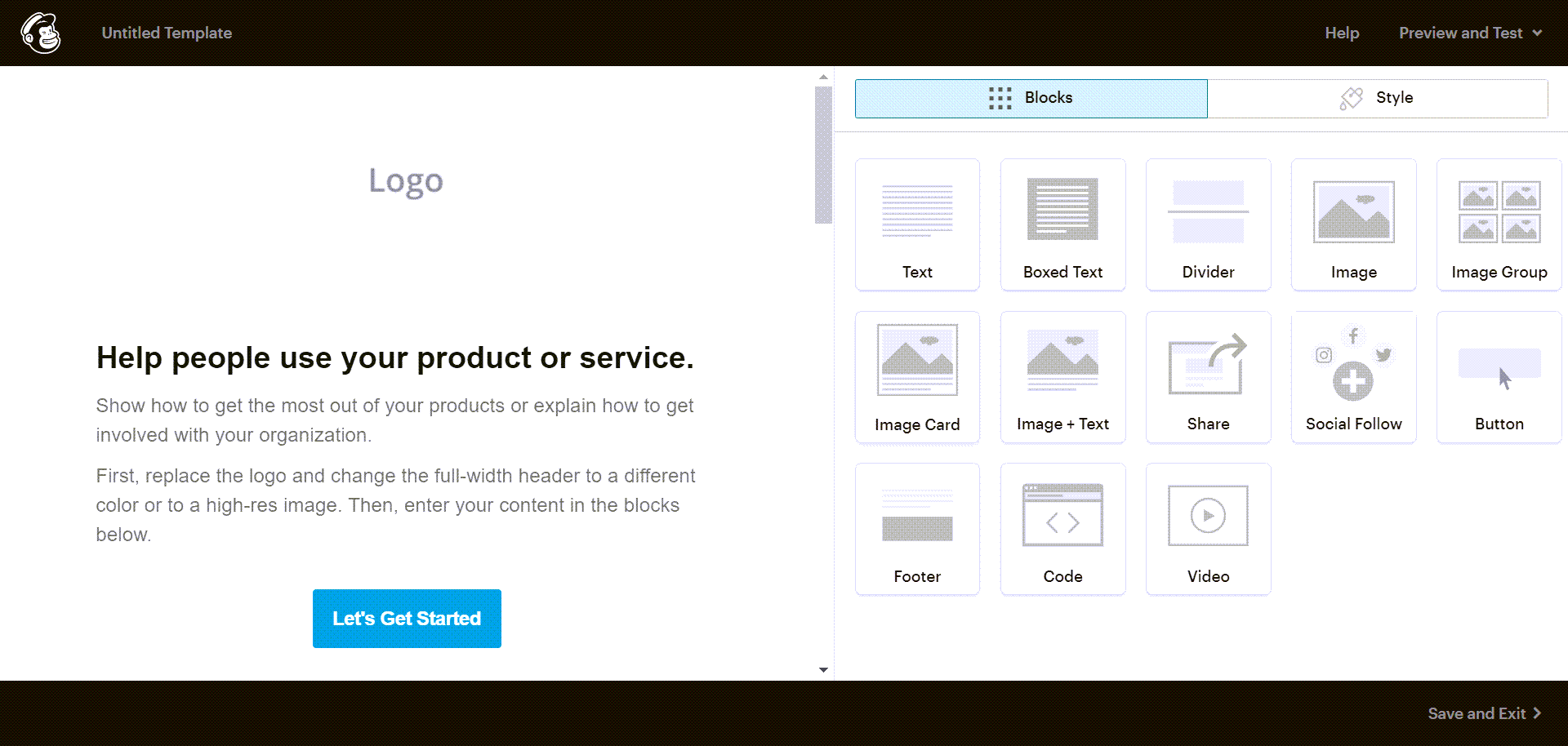
Mailchimp has two editors: the standard editor, which allows you to use pre-defined content blocks, and the custom code editor that lets you build HTML templates.
The drag-and-drop feature helps you easily add content blocks, remove them, and replicate them seamlessly.
Here are some characteristics of Mailchimp Editor:
- Speedy load time
- Drag-and-drop functionality
- CSS Inliner support by default
- Text version creation along with HTML template
#9. Geolocation Targeting
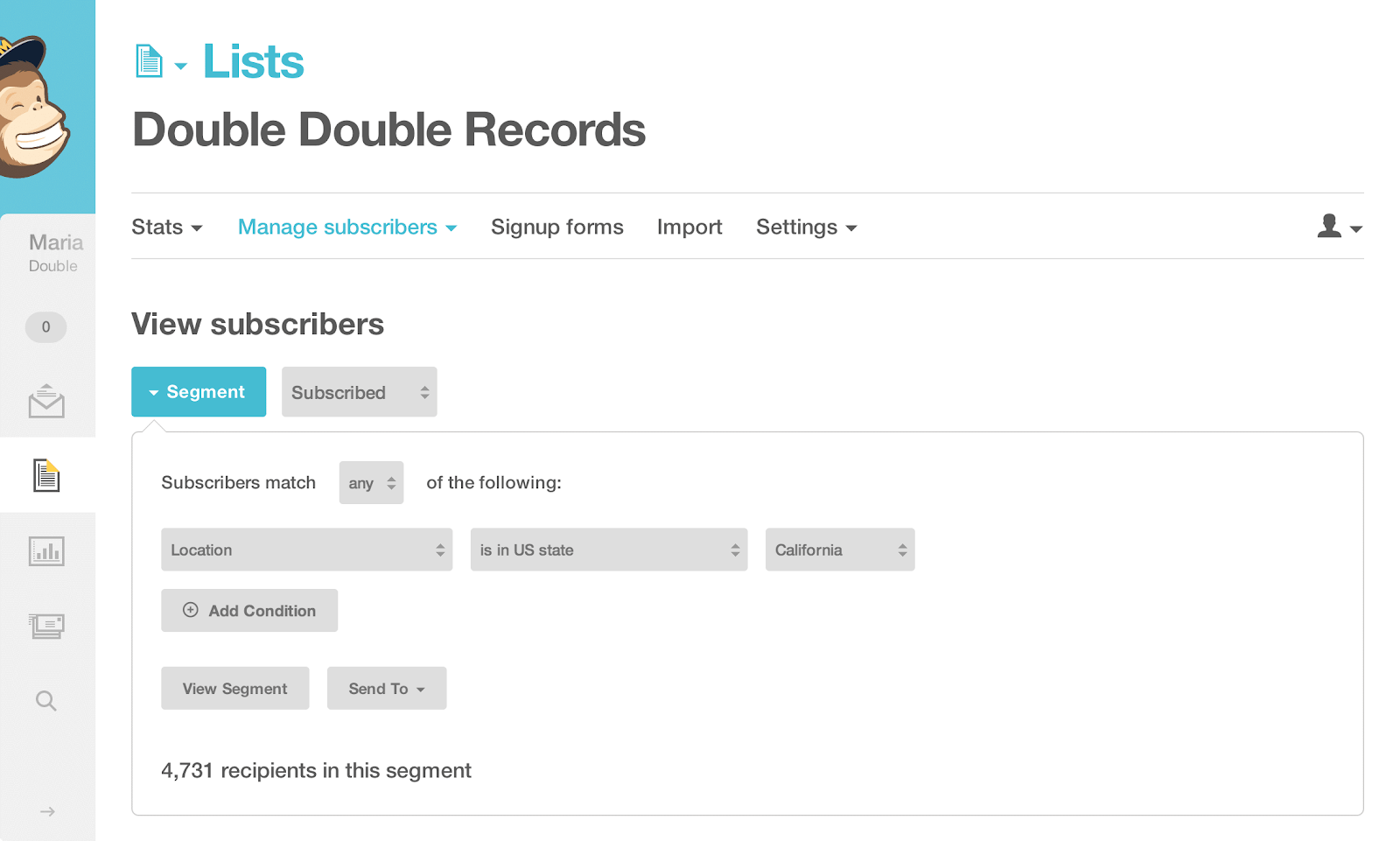
When you are running an online marketing campaign, you do not want to address all of your global clients with the same message. The geographical location of your subscriber list has a big impact on the information you deliver.
All marketers understand the need to target specific locations, such as cities, states, and countries. However, many email service providers miss this. Mailchimp does not.
Mailchimp allows you to separate your contacts based on their locations. Mailchimp identifies locations using IP addresses. However, note that if any subscribers use a VPN, you can miss their exact location.
How to Create Signup Forms
You can create sign-up forms in Mailchimp using Mailchimp form builder.
There are three different tabs on Mailchimp’s form builder – Design It, Translate It, and Build It.
The Build It tab allows you to add the content of your form and modify the structure to meet your requirement. You can also select audiences and customize settings.
In the Design It tab, you could choose the fonts, colors, and graphics that suit your form and response emails. Subsequent pages will adopt any changes made here to ensure consistency.
In the Translate It tab, you can translate your form into different languages so that you can attend to users from different geographic locations.
Embedding with Mailchimp
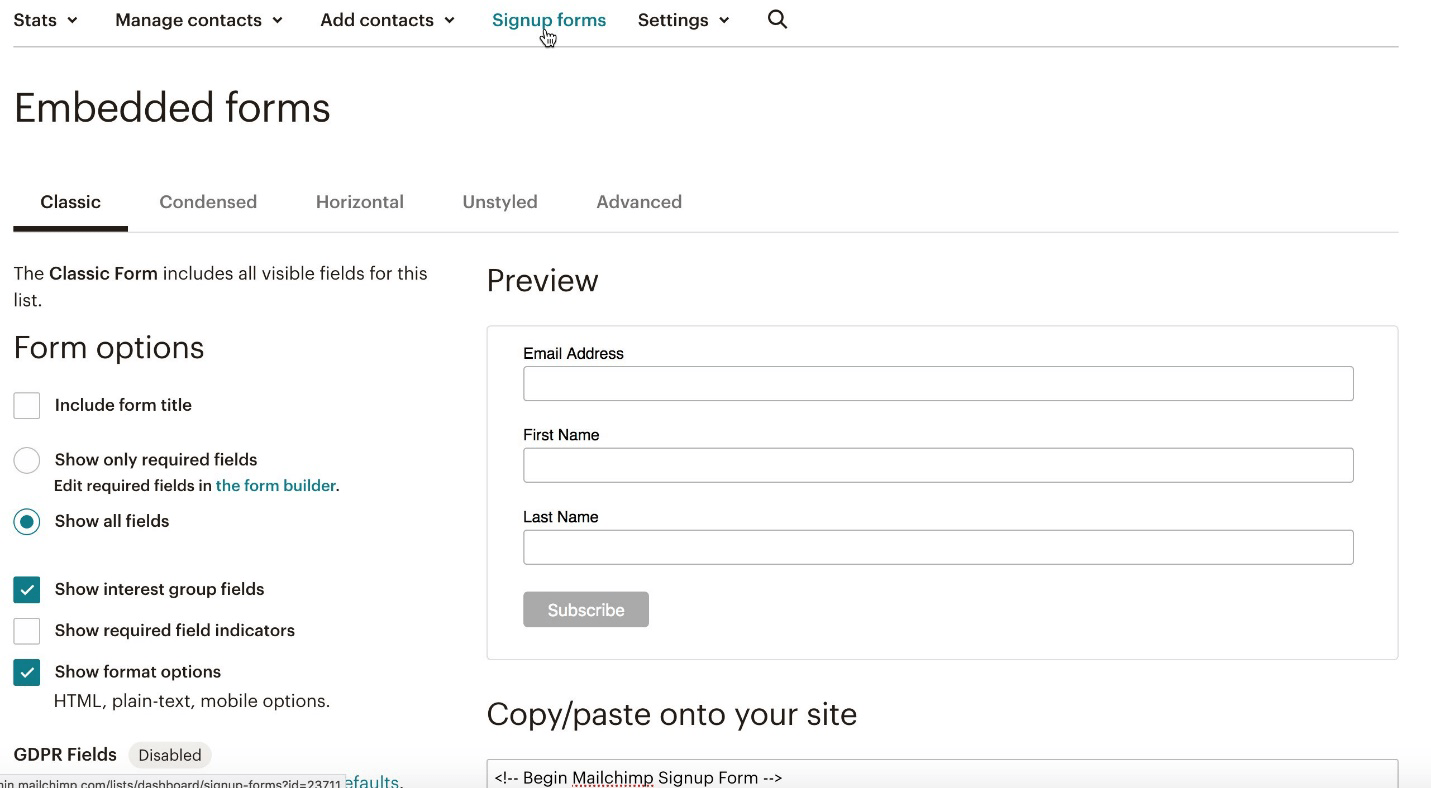
If you have a blog, you can get code from Mailchimp and embed it on your site. The form will show, and you can collect leads.
This process is easy; just copy and paste.
Creating and Sending Effective Emails
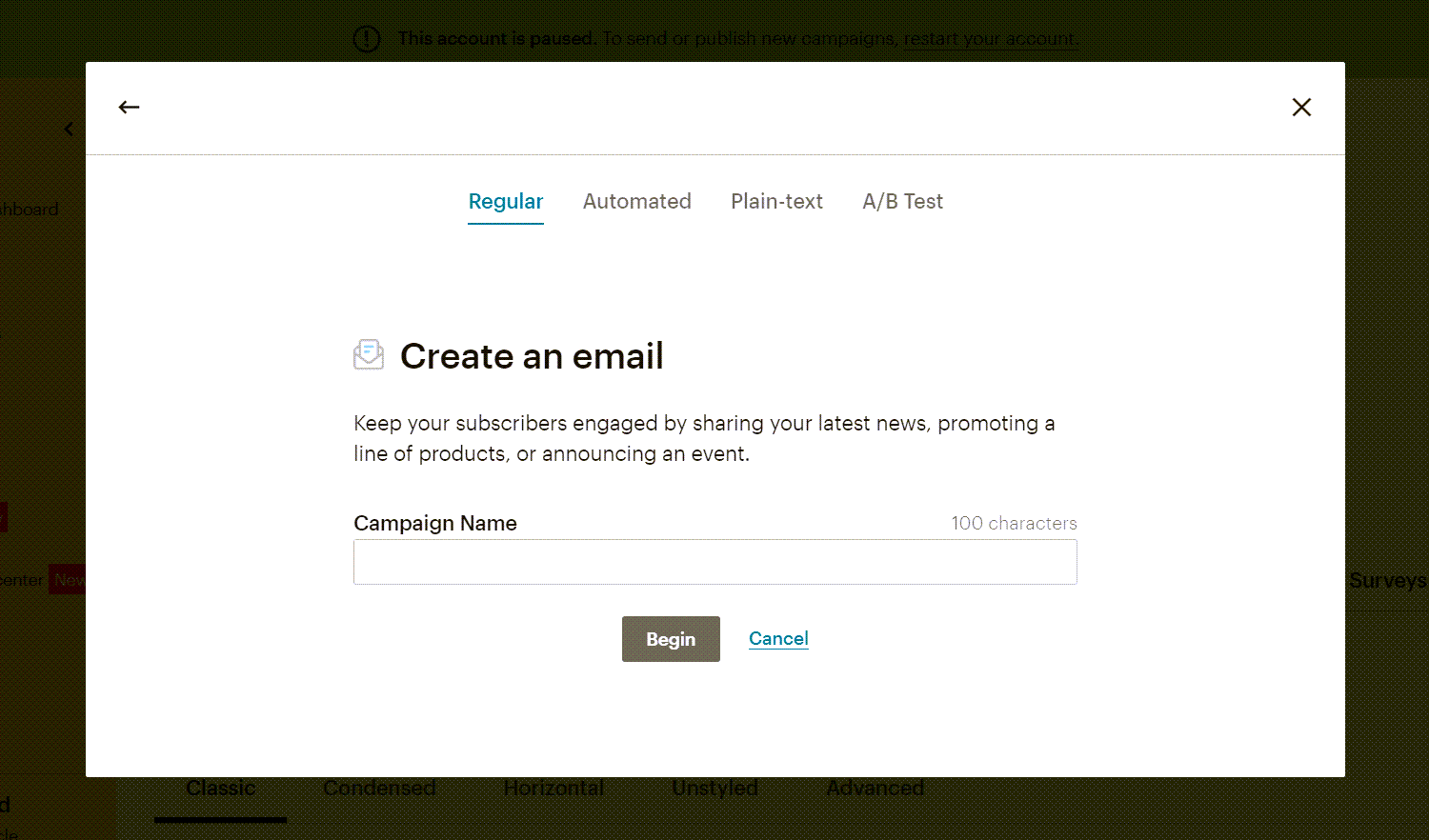
Sending marketing emails to subscribers is the heart of email marketing, and this software allows you to create and send emails swiftly.
All emails in Mailchimp are handled under “Campaigns.” As soon as you initiate a new campaign, you have some options, which are as follows:
Regular Campaign
This is the standard one-off email blast.
To initiate a Regular email campaign, assign a campaign name; then, you select the segment you wish to email.
Fill in the required information like the email subject line and sender’s email ID, etc.
Mailchimp provides you with over 50 templates, and all of them are responsive. After choosing a template, you can edit it to fit your requirements. You can preview your email on all devices before sending it, so you can make changes if required.
Finally, select when the email will be sent.
Plain-Text Campaign
This campaign is like the Regular email but without images and formatting.
This is also a one-off action. Again, you send text only and no images.
A/B Testing Campaign
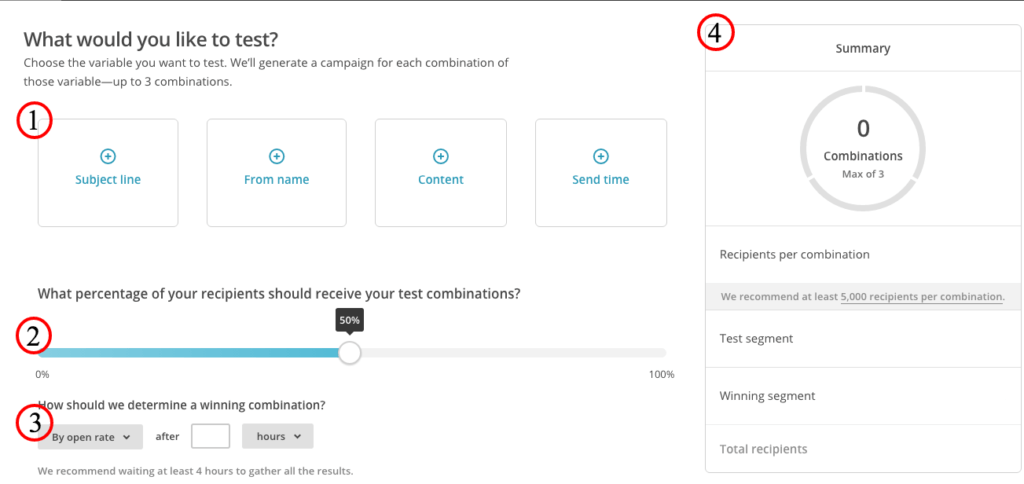
You can create an email with different versions. Here you have to provide more than one variant of the test element to test the best version. For example, you can select the subject line and opt for two choices: “coupon is inside….” and “get the coupon.”
Then you will select what percentage of emails you want to send each version. You can select 10% of emails for each version. After the test completes, Mailchimp will send the remaining emails (80%) to the best version.
Some elements you could split test are subject lines, email content, sender address, etc.
You have some options when you want to split test: subject line, sender name, content, and send time. Any option you pick would allow you to test two or three variations of it.
Mailchimp conducts the test, reviews the result, and sends the rest of the emails to the winning combination.
The A/B testing campaign is different from the Regular campaign as here you create more than one version of your campaign.
Automated Campaign
This feature allows you to create emails sent in response to specific events.
For example, you can create welcome series automation. Here, subscribers will receive a welcome email automatically after they subscribe to your newsletter and then a series of emails at a regular interval with no manual intervention.
Autoresponders is one functionality that every business appreciates.
Mailchimp Pricing Plans
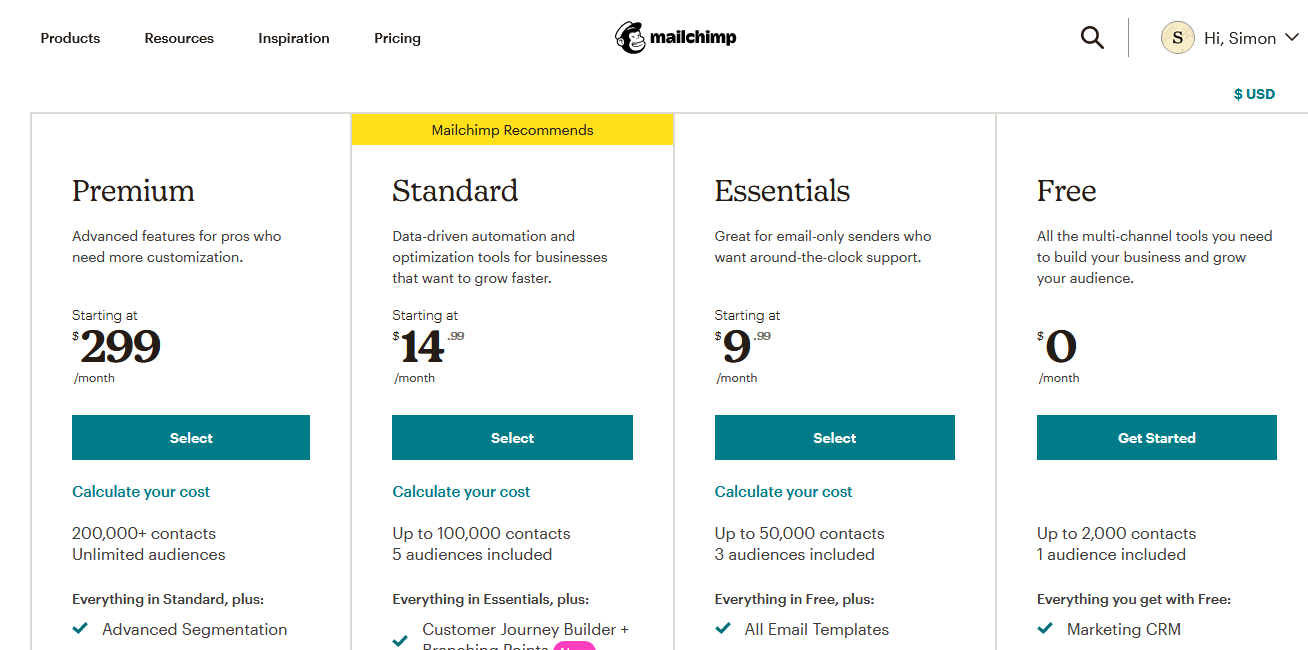
Mailchimp provides a Free plan; hence, they do not provide a free trial.
In this plan, you can have up to 2,000 subscribers and send a maximum of 12,000 emails every month.
Another distinct feature available on the free plan is the A/B testing and reporting. This feature is one that positioned Mailchimp as a front liner in email marketing parlance.
Let’s discuss the paid plans.
Some features are not accessible on the free plan; therefore, these are the paid plans:
Mailchimp Essentials Pricing Plan: It starts from 9.99 USD per month. This is the cheapest among Mailchimp’s pricing plans.
This plan has everything included in the free plan, plus you can have up to three audiences, three users, and 50,000 contacts. The price goes up based on subscriber count, A/B testing, 24/7 email support, etc.
This plan has no email autoresponder.
Mailchimp Standard Pricing Plan: It starts at 14.99 USD per month. This plan includes everything from the Essential plan plus, delivery by time zone, email autoresponders, five audiences, five users, custom templates, custom audience generation, send-time optimization, etc.
This plan is very functional and contains several features that most business owners would require to increase conversion and boost sales.
Mailchimp Premium Pricing Plan: It starts at 299.00 USD per month: This plan includes all of Mailchimp’s features. Large businesses or organizations can leverage this plan to reach out to unlimited audiences.
The benefits you get from this paid plan are immense. They include unlimited contacts, unlimited emails monthly, Live Chat Support, custom branding, multirative testing, email support, comparative reports, phone support, and advanced segmentation features.
Some Distinct Features of This Plan Include:
- Delivery by Time Zone: You can send an email at a pre-defined time as per the recipient time zone. This action would lead to the generation of more conversions and interactions.
- Multivariate Testing: This is a deep level of split testing, and it works better on large lists.
- Analyzed Demographics: Mailchimp can estimate the age and gender of your subscribers. This segmentation allows you to send more specific and higher performing emails to users.
Customer Support
What happens when you get a bug, or you are stuck in operation?
I have used Mailchimp for many years and received quick responses to my support requests.
They don’t offer support on the free plan after 30 days of setting an account.
The unlimited support is for the paid version. However, their knowledge base is robust and contains many articles, user guides, and video tutorials to help you. You can always count on these guides to help you start using your account efficiently.
Pros & Cons of Mailchimp
This Mailchimp review will be incomplete if we didn’t discuss the pros and cons of Mailchimp.
Mailchimp Pros
#1. Free Plan
This is the biggest advantage of Mailchimp and possibly the main reason for Mailchimp’s popularity. I also joined Mailchimp because of the free plan and have stuck with them for many years. Even now, no other service providers offer a free plan with 2,000 subscribers free. However, recently, a few have started offering 500-1,000 subscribers in the free plan.
#2. Powerful Automation
Mailchimp has powerful automation that large organizations can use. It can help you build sales funnels, manage CRM, etc.You can create ads and re-target audiences using Mailchimp inbuilt features.
#3. Useful Mobile App
You can manage your email marketing with Mailchimp mobile app. Very few email marketing service providers have this feature.
You can see a detailed report of your campaigns and you can add or remove a contact. My favorite feature is to resend campaigns to non-openers.
You can resend your campaign to subscribers who did not open it during the first campaign with one touch. This increases the opening rate by around 5-10%.
#4. High Deliverability
Mailchimp takes the spam issue seriously, and they have the strictest policy against spam. If they feel you are spamming the audience, they will immediately block your account. For this reason, their servers have a high reputation, and so the deliverability rate is high.
I also noticed that their analytics are more accurate. After leaving Mailchimp to try a few other email service providers, I noted the open rate is less with others than with Mailchimp. I think it is because they don’t capture all openers.
Cons of Mailchimp
#1. Mailchimp is Expensive
Mailchimp is expensive as compared to other email marketing service providers. I used Mailchimp for over seven years, but when my subscribers count approached ten thousand, I shifted to MailerLite, which was much cheaper than Mailchimp.
Another reason for my migration was that Mailchimp announced a new pricing structure and said they will start to count unsubscribed subscribers toward the account limit. So if you have 10,000 active subscribers and 2,000 unsubscribed subscribers, Mailchimp will charge for 12,000.Usually, when any email marketing service provider increases the price, the change won’t affect the existing users.
For example, a few months back, MailerLite increased their price, but my pricing plan remains unchanged.
However, this is not true with Mailchimp; they announced the price increase and said all users might pay the higher price in the future.
Moreover, if you have common subscribers in two lists, Mailchimp will count them as separate subscribers. So if you have the same subscribers on multiple lists, your cost will increase. Many other email marketing platforms do not count these subscribers as duplicates.
For example, MailerLite and ConvertKit consider a subscriber singularly even if you have them on multiple lists.
#2. Outdated Interface
Though recently Mailchimp updated their interface to make it user-friendly, it still lacks a modern look and feel. I realized this when I started looking for Mailchimp alternatives.
I settled on MailerLite and was amazed by its interface. It is neat, clean, and there is almost no learning curve.
I have used many email marketing services and noticed that old email marketing service providers such as Mailchimp and AWeber do not have the best interface. However, the newer services, such as MailerLite, have a modern and pleasant interface.
#3. Mediocre Templates
Mailchimp provides many templates for sign-up forms and email newsletters. These are well-designed templates, but you must use them as-is; customization is not easy.
I wish they would provide more templates.
However, this is not just Mailchimp. I have used a few email marketing service providers and find the same issue with them.
I use Thrive Leads to design sign-up forms. It is flexible, powerful, and provides A/B testing features. Using a third-party service to design sign-up forms has its advantages, such as:
- You can have high converting opt-in forms
- You can change your email service provider without affecting the sign-up forms.
I recommend using a third-party plugin to design sign-up forms.
Mailchimp Review – Conclusion
Mailchimp is the oldest and the biggest email marketing service provider. They have many features to help grow small and large organizations. You can use their advanced automation, CRM features to your benefit. If you are looking for an enterprise-ready email marketing service provider, you should go for Mailchimp. It is a good choice for beginners as long as they don’t have more than 2,000 subscribers.
Click here to visit Mailchimp Website.
I hope you found this Mailchimp review useful; please share your opinion on Mailchimp through the comments section.



